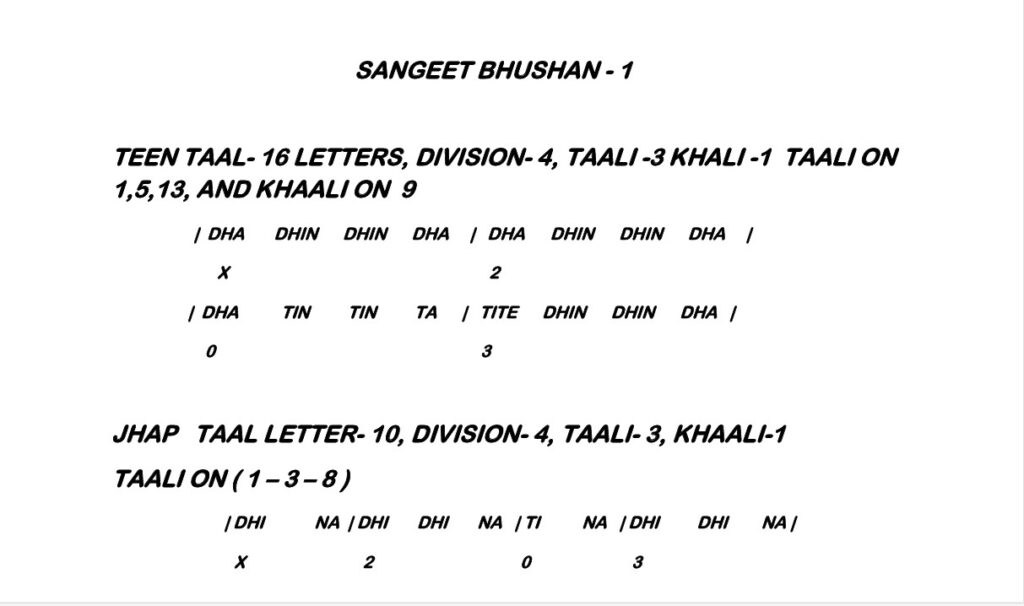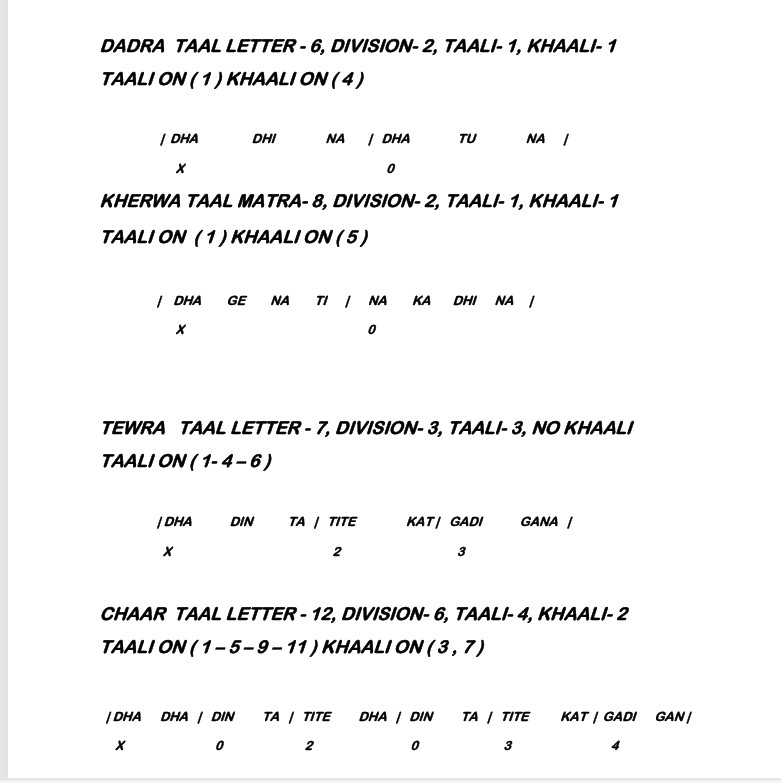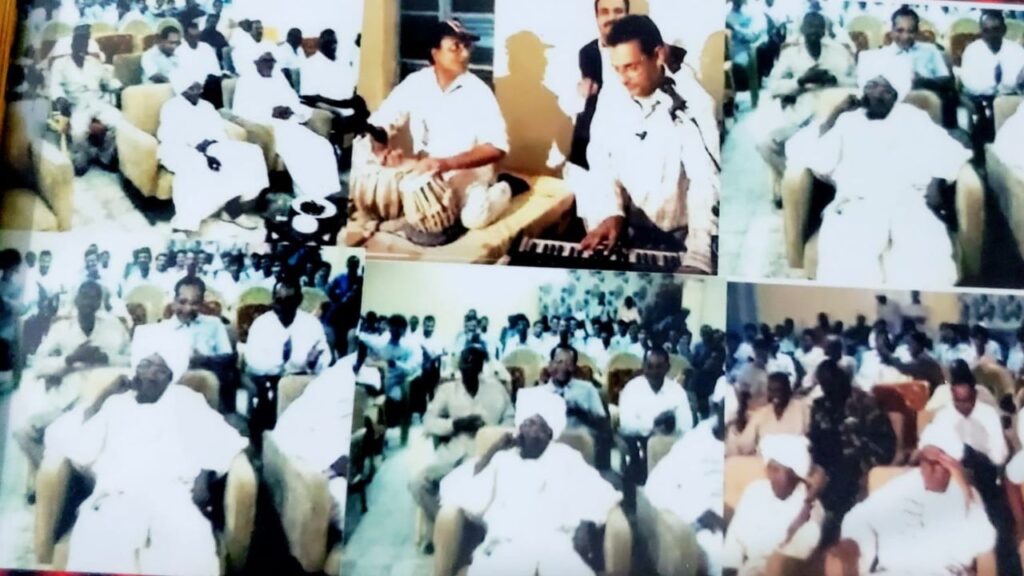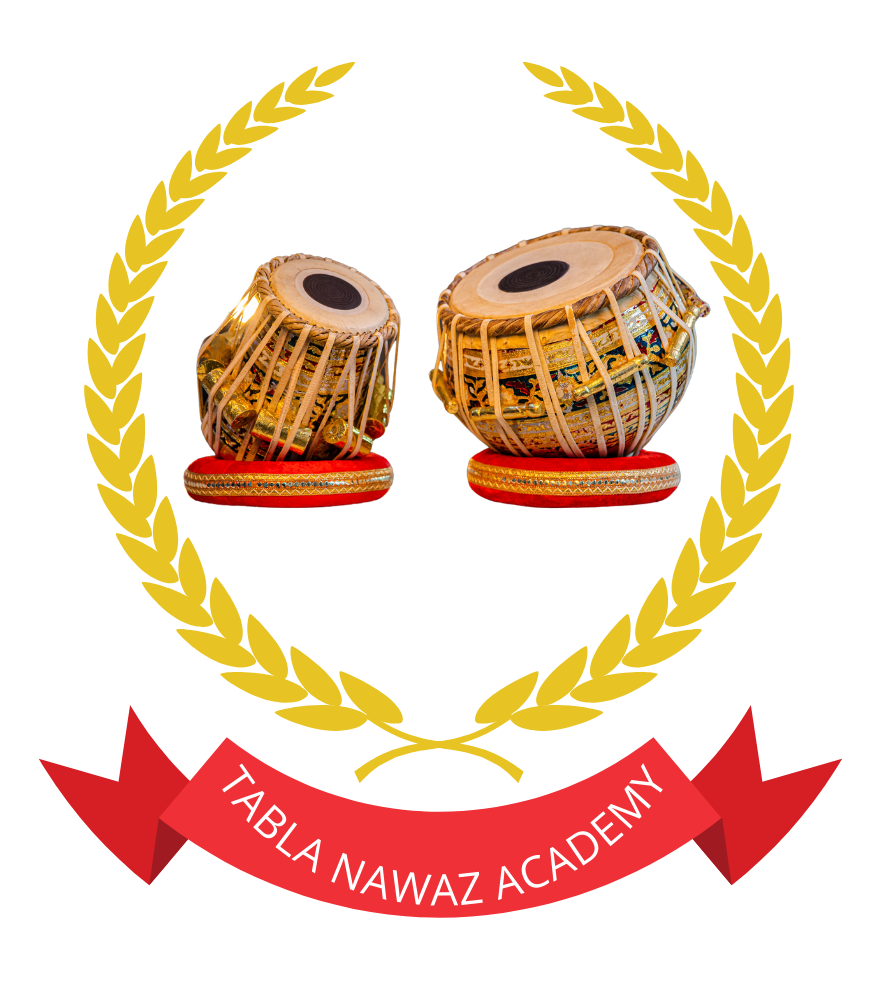The Sangeet Bhushan Part-1 Tabla syllabus for the 2024/25 session offers a structured introduction to the art of tabla playing, blending theoretical knowledge with practical skills. This foundational course is designed to equip students with the essential techniques and understanding required for proficiency in tabla performance.
- Sangeet Bhushan part -1 having six taal
- Teen Taal
- Jhap taal
- Dadra taal
- kehrwa taal
- Tewra taal
- Chautaal
Course Overview
The curriculum is divided into two primary components: Theory and Practical.

Theory Component

The theoretical segment aims to provide students with a comprehensive understanding of the fundamental concepts of Indian classical music and tabla. Key topics include:
- Basic Terminology: Definitions and explanations of essential terms such as Sangeet (music), Naad (sound), Shruti (microtone), Swara (note), Saptak (octave), Taal (rhythmic cycle), Laya (tempo), Matra (beat), Sam (the first beat of a cycle), Tali (clap), Khali (empty beat), Avartan (cycle), and Theka (basic rhythmic pattern).
- Notation Systems: An introduction to the notation systems developed by Pt. Vishnu Digambar Paluskar and Pt. Vishnu Narayan Bhatkhande, which are essential for documenting and interpreting tabla compositions.
- Taal Structure: Understanding the structure and characteristics of various taals, including their divisions (Vibhag), claps (Tali), and empty beats (Khali).
Practical Component
The practical aspect focuses on developing hands-on skills in tabla performance. Areas of emphasis include:
- Basic Strokes (Bol): Mastery of fundamental tabla strokes such as Dha, Dhin, Tin, Na, and others, which form the building blocks of more complex compositions.
- Elementary Compositions: Practice of simple compositions, including Kayda (a type of composition that follows specific rules), Tukda (a short composition), and Prakar (variations), to build a repertoire and enhance performance skills.
- Prescribed Taals: In-depth study and practice of specific taals such as Teentaal (16 beats), Jhaptaal (10 beats), and Dadra (6 beats). Students learn to play the Theka of each taal, along with simple variations and improvisations.
- Tempo Variations: Ability to perform compositions in different tempos, including Ekgun (single speed), Dugun (double speed), and Chaugun (quadruple speed), to develop rhythmic versatility.
Assessment and Evaluation
The course typically allocates marks between theory and practical examinations, with a common distribution being 50 marks for theory and 100 marks for practical performance. Assessments may include:
- Theory Examination: Written tests covering definitions, notation, and understanding of taals and their structures.
- Practical Examination: Demonstrations of basic strokes, performance of prescribed compositions, and the ability to play taals with accuracy in various tempos.
Learning Outcomes
Upon successful completion of the Sangeet Bhushan Part-1 Tabla course, students are expected to:
- Have a solid understanding of the fundamental concepts and terminology related to tabla and Indian classical music.
- Demonstrate proficiency in basic tabla strokes and the ability to perform simple compositions.
- Accurately play the Theka of prescribed taals and execute tempo variations with control.
- Apply the notation systems of Paluskar and Bhatkhande to read and write tabla compositions.
Conclusion
The Sangeet Bhushan Part-1 Tabla syllabus serves as a comprehensive introduction for beginners, laying the foundation for advanced study in tabla performance. By integrating theoretical knowledge with practical application, the course fosters a deep appreciation for the intricacies of tabla and prepares students for further exploration of this rich musical tradition.
For more detailed information on the syllabus and enrollment procedures, prospective students are encouraged to consult official resources or contact accredited music institutions offering this program.
Sangeet Bhushan Part-1 Tabla Syllabus (Session 2024/25)
The Sangeet Bhushan Part-1 Tabla syllabus for the 2024/25 session is a foundational course designed to introduce students to the rhythmic art of tabla playing. This program balances theoretical knowledge and practical skills, enabling students to gain a comprehensive understanding of the instrument. It is ideal for beginners looking to establish a strong base in Indian classical music.
Syllabus Overview
Theory Section
The theoretical component aims to build conceptual clarity about tabla and Indian classical music. Key topics include:
- Basic Terminology:
- Understanding terms like Naad (sound), Taal (rhythmic cycle), Laya (tempo), Matra (beats), Theka (basic rhythmic pattern), and more.
- Taal Structure:
- Study of talas such as Teentaal (16 beats), Jhaptaal (10 beats), and Dadra (6 beats), with their components like Sam (starting beat), Tali (clap), and Khali (empty beat).
- Notation Systems:
- Introduction to Pt. Vishnu Digambar Paluskar and Pt. Vishnu Narayan Bhatkhande’s notation systems for documenting tabla compositions.
Practical Section
The practical component focuses on hands-on learning, including:
- Basic Tabla Strokes (Bol):
- Learning essential sounds like Dha, Dhin, Na, Tin, and others.
- Compositions:
- Playing basic compositions like Kayda (structured rhythmic patterns), Tukda (short compositions), and Prakar (variations).
- Taal Practice:
- Performance of Thekas in various talas such as Teentaal, Jhaptaal, and Dadra, with simple variations.
- Tempo Control:
- Playing talas in different tempos: Ekgun (single speed), Dugun (double speed), and Chaugun (quadruple speed).
Assessment and Evaluation
- Theory (50 Marks):
- Written exams focusing on definitions, structure of talas, and notation.
- Practical (100 Marks):
- Demonstration of tabla strokes, Thekas, and compositions with tempo variations.
Learning Outcomes
By the end of this course, students will:
- Have a clear understanding of tabla terminology and rhythmic structures.
- Be able to perform basic compositions and talas with accuracy.
- Develop foundational skills to pursue advanced tabla training.
- Learn to document and interpret tabla compositions using standard notation systems.
The Sangeet Bhushan Part-1 Tabla syllabus offers an enriching learning experience, ensuring students build a strong connection with the classical art form. It sets the stage for deeper engagement with tabla in future levels of musical education.
https://www.youtube.com/@BhagawanSingh
https://www.facebook.com/sbsinghtablaguru


